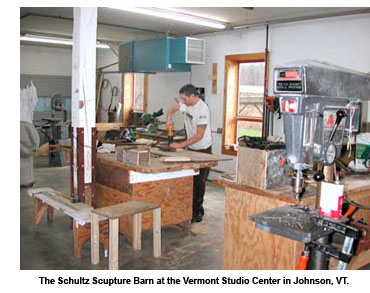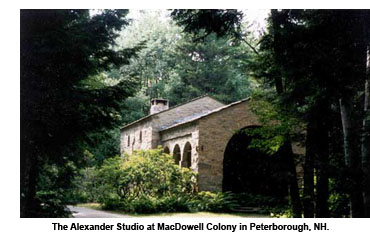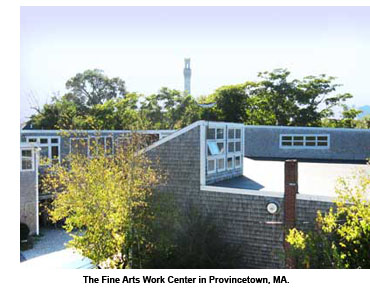Ten Great Artists Residencies
Summer camp. That’s how one artist described his nine weeks spent at Skowhegan. That’s not to say that the residency was just fun and games, because he did work. He reflected on the fields and mountains, how he relaxed and bonded with other artists, and lived and breathed art every day. For him, it was a once-in-a-lifetime experience, changing him and his art—forever.
“Often a residency is a transitional time in an artist’s career,” says Caitlin Strokosch, executive director of the Alliance of Artists Communities. It can provide “uninterrupted studio time to focus on a project, and access to facilities to execute it.”
The Alliance of Artists Communities, based in Providence, Rhode Island, represents national and international artists communities that offer over 1,000 artists residencies. The programs vary widely. Some ask the artist to teach or become involved in the community. Some provide accommodations and meals, specialized facilities, stipends, or scholarships. Some offer little more than an isolated cabin in the woods or a shack on the beach.
Before selecting a residency, it’s a good idea to consult the Alliance of Artists Communities website, www.artistscommunities.org, which provides a full listing of its member residencies. Access to the database requires a subscription of $25, yet enables one to search residencies by discipline, location, time of year, duration, financial aid options, and more.
The following offers a sampling of great residencies within New England:
1. Skowhegan School of Painting and Sculpture: Skowhegan, Maine
A summer art school founded by artists in 1946, the Skowhegan School of Painting and Sculpture is still run by artists. Located on 330 acres of land near Lake Wesserunsett, Maine, this intensive nine-week residency runs mid-June to mid-August. Highly competitive, the program selects sixty-five artists from over 2,000 applications. Disciplines vary widely from painting to book arts. In addition to studio space, artists are given access to a metal and wood shop, a basic darkroom, a multimedia lab, and a library. Visiting artists critique resident’s work.
Artists live on campus, and share basic housing and meals. The cost is $5,500, though ninety-five percent of participants are eligible for financial aid. Apply online at www.skowheganart.org. Deadline is February 1, 2011.
2. Vermont Studio Center: Johnson, Vermont
Founded in 1984 by artists, the Vermont Studio Center (VSC) is composed of thirty historical buildings located along the Gihon River in the northern Green Mountains. It is the largest international artists and writers residency in the U.S. Forty visual artists in painting, sculpture, new and mixed media, drawing, printmaking, and photography are accepted each month.
Residencies last from four to twelve weeks. Artists receive a private studio, modest private accommodations, organic meals, and classes in meditation and yoga. The Center offers specialized facilities, such as a print shop and sculpture and photography studios. Models for life drawing are available. Four visiting artists give lectures and individual studio visits. Residents can share their work during open studios and presentations. The cost is $3,750, half of which can be covered by grants and participation in a work exchange program (based on merit and need). Many fellowships are available. In addition, the VSC offers a low-residency Masters of Fine Arts program through nearby Johnson State College.
Applications to the residency are accepted on a rolling basis. Deadline for fellowships begin February 15. For complete details, check out the website at www.vermontstudiocenter.org.
3. Seven Below Arts Initiative: Burlington, Vermont
Seven Below was established in 2006 in partnership with Burlington City Arts, an arts center in downtown Burlington. The six-week summer residencies are held outside the city in a 200-year-old barn situated on sixty-five acres of land. The barn, used by Phish and other musicians as a recording studio, provides working and living space for three artists.
The residencies are open to artists at any stage in their career and are designed to provide a peaceful, inspiring, and supportive environment for individual and/or collaborative new work. Application forms are posted online under “Artist Opportunities” at www.burlingtoncityarts.com.
4. MacDowell Colony: Peterborough, New Hampshire
 The MacDowell Colony, founded in 1906 by composer Edward MacDowell and his wife, is the oldest of the New England artists residencies. Providing thirty-two studios for artists year round, the Colony is surrounded by 450 acres of woodlands and fields. For privacy, almost no studio is within sight of another. Every year, 250 artists are selected to spend up to eight weeks enjoying the peace and quiet of the place and focusing on their art. The Colony has studios set up for photographers and printmakers. Admission is free and includes private accommodations and meals. Colony Hall, the main building, serves breakfast and dinner and provides community space for social gatherings and studio presentations.
The MacDowell Colony, founded in 1906 by composer Edward MacDowell and his wife, is the oldest of the New England artists residencies. Providing thirty-two studios for artists year round, the Colony is surrounded by 450 acres of woodlands and fields. For privacy, almost no studio is within sight of another. Every year, 250 artists are selected to spend up to eight weeks enjoying the peace and quiet of the place and focusing on their art. The Colony has studios set up for photographers and printmakers. Admission is free and includes private accommodations and meals. Colony Hall, the main building, serves breakfast and dinner and provides community space for social gatherings and studio presentations.
Deadline for summer is January 15. Apply online at www.macdowellcolony.org.
5. Peaked Hill Trust: Cape Cod, Massachusetts
Another kind of solitude can be found at the tip of Cape Cod, in the dunes of the National Seashore. Since 1996 the Peaked Hill Trust offers the Margo-Gelb shack, a one-room shelter without electricity or running water, to artists and writers for a nominal fee of $300 for two weeks. Staying at the Margo-Gelb shack is akin to camping with the Atlantic Ocean just a few hundred feet away. In return, artists are asked to participate in an exhibition, reading, or presentation to a local school.
Another dune shack is C-Scape, available to three visual artists for three-week stays. Selected artists receive a $500 stipend and they must allow visitors, through the National Seashore’s Interpretive Program.
In addition, a Community Residency of one week is available in the spring or fall. Anyone can apply and awards are made by lottery. Members of the Friends of C-Scape Residency can enter another lottery for three more one-week stays in the dune shack. Memberships and applications for both shacks are handled by the Truro Center for the Arts at Castle Hill, www.castlehill.org. Deadline is February 10.
6. Fine Arts Work Center: Provincetown, Massachusetts
From October to May, the Fine Arts Work Center offers seven-month fellowships to writers and visual artists who are in the early stages of their careers. Twenty fellows receive a modest monthly stipend and are provided with apartments and small, separate working studios. Facilities include a basic woodshop, a print shop with etching press, and a darkroom with basic equipment. Visual artists present exhibitions at the Center’s Hudson D. Walker Gallery. Deadline is February 1. Apply online at www.fawc.org/fellowships.
7. Center for Contemporary Printmaking: Norwalk, Connecticut
For printmakers, the Center for Contem-porary Printmaking is dedicated to the art of print, paper works, book arts, and digital arts. One-week to one-month residencies provide established and emerging artists opportunities to realize printmaking projects through time, equipment, and creative support. Residents live and work in the Helen Frankenthaler Printmaking Cottage next to the historic carriage house that the CCP shares with the Grace Ross Shanley Gallery.
Artists can create an edition, explore new media, and advance their printmaking work. Participants may work independently or, for a fee, work with one of CCP’s printers. As part of the residency, the artist is expected to present his/her work in an exhibition or offer a workshop with young artists. Check out the website for more information, www.contemprints.org.
8. Billings Forge Community Works: Hartford, Connecticut
Recognizing that artists can serve as catalysts for neighborhood revitalization and economic stimulation, Billings Forge Community Works provides free studio space to artists interested in community projects; artists have the option of staying six months or a year. In exchange, artists must teach a class and volunteer five hours each week. Materials deadline is January 3. More information can be found at www.billingsforgeworks.org.
9. AS220: Providence, Rhode Island
Unlike the other residencies mentioned, AS220, an alternative art space, does not accept applications. In keeping with AS220’s mission—“unjuried and uncensored, all the time”—an artist wanting a month-long residency needs staff sponsorship. Accepted artists live in the studio on the third floor of the Empire Street studios and gain access to all of AS220’s facilities, such as the darkroom and print shop. Participating artists are expected to exhibit or perform their work. More information can be found at www.as220.org.
10. Omi International Arts Center: Ghent, New York
Omi International Arts Center provides residencies for international visual artists, writers, musicians, and dancers. Their Art Omi program is a four-week residency which proves artists with a studio, living quarters, and meals at no cost. Each year approximately thirty emerging and established artists are selected to spend the month of July on 300 acres of farmland in the Hudson Valley overlooking the Catskills Mountains and the Fields Sculpture Park.
Art Omi offers several fellowships to assist with travel and material costs, and a number of residents can work with a master printmaker to produce an edition of monotypes. A critic-in-residence lives on campus with artists to lead discussions and make one-on-one studio visits.
At the end of the residency, Art Omi hosts an open studio day for the general public and each artist is asked to donate something created during the residency to the Art Omi Collection. To learn more visit, www.artomi.org.
_________________________________________________________________________________________________________
Martina Windels is an award-winning designer and former faculty member of the Rhode Island School of Design. Her articles have appeared in American Craft, Big, Red & Shiny, and Metalsmith.
